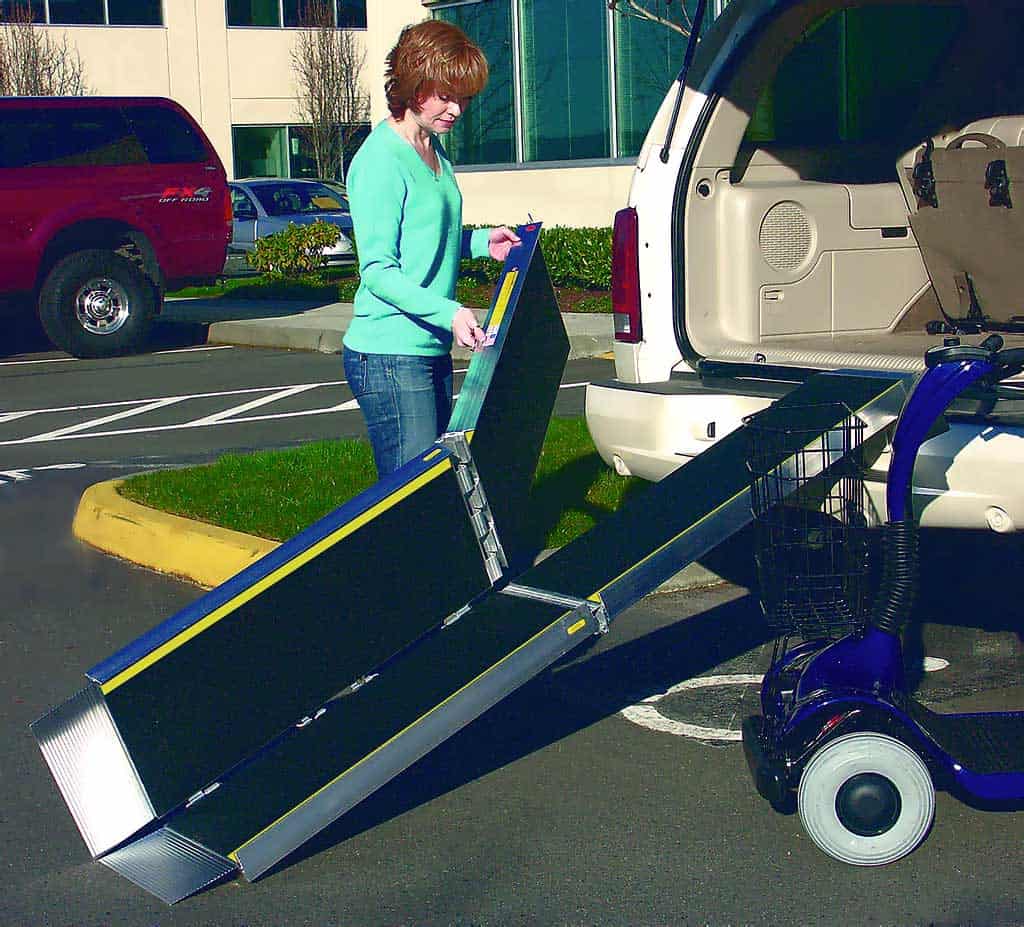Wondering whether a ramp or lift makes the most sense for your home environment? There are distinct advantages to both- as well as features that tease-out the best option for your living situation. Consider ease, permanence, effort, and costs before making a determination about which one suits you best- and always talk with qualified mobility vendors to learn more and gain insight into both aids.
If you want to increase accessibility around the home, you can’t go wrong with aids to make life a lot easier. When it comes to choosing between stairlifts and ramps, it is like distinguishing apples from oranges: these are both very-different aids with distinctive features and purposes. Before you buy the wrong equipment to enhance access and preserve autonomy, consider talking with a mobility professional to learn more about all your options.
A ramp or a lift? You decide:
Effort
The first consideration is how much effort it will require to gain access with a ramp versus a lift; since ramps are typically used in conjunction with wheelchairs, scooters, canes, walkers, or railings, it is hard to measure how much effort will be needed to enter or exit. In terms of helping navigate a small set of steps or stairs, a portable ramp will require effort to implement and move, as needed. Stairlifts are generally installed by the retailer professionally, so the effort lies in seating one’s self and using hand controls to ascend a stairway. In short, lifts do the work for you in most instances.
Permanence
Think about the permanence of the mobility aid; how long will you need or have a stairlift installed? The fact that ramps are portable and can be stowed away when not in use makes them very versatile, though they may not hold up well over time to heavy use or the elements. Stairlifts typically come with a warranty or guarantee, so they should be reliable for years to come. A stairlift is less versatile in terms of moving when not in use, though they are easy enough to navigate and pass on conventional staircases by non-users.
Value
A stairlift will generally retain its value over time, while ramps are more prone to deterioration due to the sheer nature of what they provide. While there is always a market for used mobility aids, selling a used ramp may not return as much of the investment as you could likely see from a stairlift.
Ease
What about ease of use? Lifts are considered easier due to the hand controls and operation with the touch of a button; ramps require you to do some work. When discussing ease of these varied mobility aids, it also is impacted by the user’s physical condition and nature of their mobility challenges.
Comfort
Let’s talk about comfort: is it more comfortable to use a ramp or a lift? If you have never experienced or tried a stairlift, you may be surprised at how comfortable and simple they are to use. The user sits on the chair at the foot (or top) of the stairs and secures themselves in with a safety belt; next, they use hand controls to ascend the stairs, with a similar platform on the opposite end of the stairs for exiting the stairlift.
As for a ramp, it may be more comfortable to not lift legs to climb stairs but if you use a chair or walker, you may find the incline is challenging or even painful. The best way to pinpoint which aids can enhance your quality of life and bring comfort is to discuss options with your doctor, and then visit a reputable mobility dealer in your region. Plus, this will give you an opportunity to try and demonstrate some available options for yourself!
Rentals
There are rental opportunities and potential to try stairlifts from many vendors before you decide to purchase your own- or if you only need one temporarily for rehabilitation after surgery or an injury. As for ramps, you may also find these at medical supply rental companies, though they are usually the folding, portable kind. In a sense, both ramps and lifts have similar potential for consumers to rent.
Expense
If you are looking at a permanent ramp, you will need to consider the costs based on what a carpenter or contractor will charge plus materials. For portable ramps, no real installation is needed beyond initially setting it in place and securing it. As for stairlifts, installation couldn’t be easier as any reputable dealer is going to provide professional installation with purchase. Make sure that this is included in the arrangements that you make when buying your lift- or any other mobility equipment. Professional installation truly is the safest route to take.
Trying to decide between a ramp and a stairlift? There could be an argument made for buying both and using them in tandem or together to enhance overall home accessibility. Talk to a professional at Pacific Mobility to find out what distinguishes one from the other- as well as which equipment and aids make the most sense for your home, condition, and budget.
President, Husband, Father, Grandfather Graduate of UC Davis- Bio Sci Major- Go Aggies! Jeff has extensive experience in all of Pacific Mobility’s products and services, and specializes in accessibility products as well as stairlifts, ceiling lifts and custom wheel chairs. His hobbies include spending time with family, gardening, mountain biking, exercising and off road motorcycle riding.
24 years as Owner/President of Pacific Mobility Center – selling, installing, and servicing stairlifts, porch lifts, ceiling lifts, pool lifts, handicap ramping, specialty wheelchairs, scooters, power wheel chairs, and other power mobility devices
Certified Environmental Access Consultant since 2008
Licensed General Contractor since 1998
Certified Aging in Place Specialist since 2016
Board Member for Home Access Professionals
Member of Association of Members of the Accessibility Equipment Industry (AEMA)




